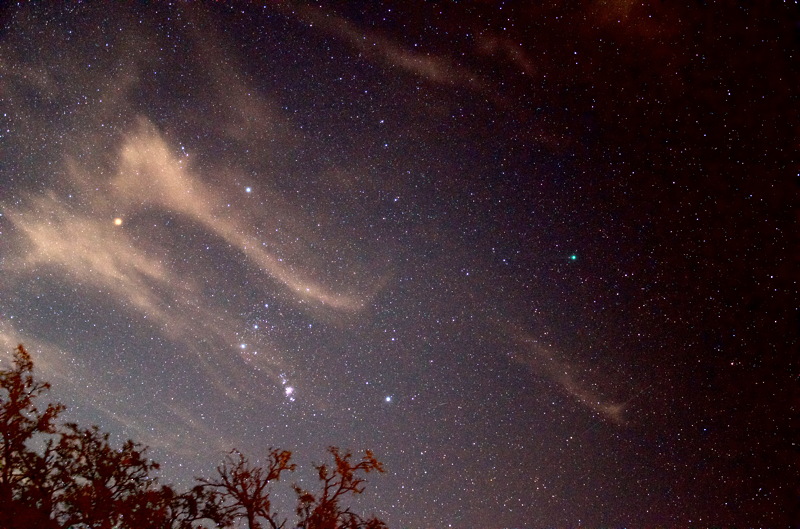Imaging: Comet C/2014 Q2 (Lovejoy)
Posted: 7 January 2015
|
Open: Tuesday, 6 January 2015, 1818 MST Temperature: 60°F |
Session: 766 Conditions: Some clouds |
Just before opening the observatory I took this photograph of Venus and Mercury low in the western sky, D7000 DSLR, f/11, 1/10sec, ISO 1600, FL 105mm:

Mouseover or tap on image for labels
1832 MST: Comet C/2014 Q2 (Lovejoy) was easily naked eye visible. Manually slewed the 8" LX200-ACF to the comet and centered it in the 7x50 finderscope. Nice view at 83X. Then began setting up for comet imaging. Mounted the D7000 DSLR piggyback on the 8" telescope. Slewed the telescope to the star Rigel and focused the camera lens at a focal length of 105mm. Slewed back to the comet; it was visible in the camera viewfinder. Did some test exposures. Oops, camera focus changed. Slewed back to Rigel to refocus, then back to the comet. Did a series of exposures at various exposure settings. This image was taken at 1911 MST, f/5.6, 2 minutes, ISO 4000, FL 105mm:

The comet's tail is faintly visible streaming to the left of the comet. Unfortunately, by this time thin clouds were near the comet, as seen in the photo above, and the eastern sky was beginning to brighten due to the rising waning gibbous moon.
I reduced the lens focal length to 18mm and took this wide angle sky photo showing Orion at the left above the telescope tube and comet at the center. Clouds are evident. The exposure was f/3.5, 1 minute, ISO 4000.

Mouseover or tap on image for labels
I increased the focal length to 30mm and took this photo, f/4.2, 30 seconds, ISO 4000:

Mouseover or tap on image for labels
Added a f/6.3 focal reducer to the 8" telescope and mounted the D7000 DSLR at prime focus. Did a focus test on the star Rigel using a Bahtinov Mask. Slewed back to the comet; it was visible in the camera viewfinder. This is a 1 minute, ISO 6400, exposure:

Mouseover or tap on image to show tail
If you mouseover (or tap) the image above you can see an exaggerated edit that shows part of the comet's tail to the left. A slow moving faint satellite is the streak at the top of the image.
1945 MST: thin clouds were now in most of the sky, including at the comet's location. The sky was very bright due to the rising moon. Ended comet imaging.
1948 MST: viewed Comet Lovejoy, 53X. Coma and star-like nucleus were very nice. No tail was visible. The bright sky and thin clouds were not helping the view, although the comet was still faintly visible to the naked eye. Removed the focal reducer and viewed the comet at 83X.
2000 MST: the waning gibbous moon rose over the hill to the east. Took this handheld iPhone 5s afocal 83X photo of the moon with it still very low in the sky:

This had been a good dry run for imaging Comet C/2014 Q2 (Lovejoy) Wednesday evening when it should be at its brightest and the moon will rise an hour later. Unfortunately, overcast skies are forecast for the night.
|
Close: Tuesday, 6 January 2015, 2027 MST Temperature: 55°F |
|
Comments are welcome using Email. If you are on Twitter you can use the button below to tweet this report to your followers. Thanks.
Cassiopeia Observatory Home Page
Copyright ©2015 Michael L. Weasner / mweasner@me.com
URL = http://www.weasner.com/co/Reports/2015/01/07/index.html
